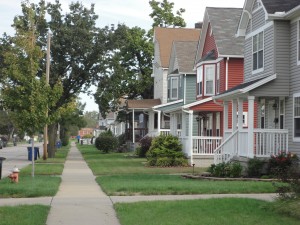On February 25, the NEOSCC Board will be voting on the the Vibrant NEO 2040 Vision, Framework and Action Products. Everyday over the next 5 weeks, we will be sharing an “Initiative A Day” so you can gain a better understanding of the vision and framework! If you would like to read all of the Initiatives, you can download them here: Recommendation and Initiatives. You can access a pdf of the entire vision chapter here. The vision chapter contains all 41 initiatives, development strategies, indicators, and matrices that identify how the recommendations, initiatives and indicators all relate.
Show your support for Vibrant NEO 2040 by adding your name to our Champions of Vibrant NEO 2040 list here!
Initiative 6.2: Repair existing sidewalks and crosswalks and add new ones as needed wherever a fixed-route bus service is in operation.

Quality pedestrian facilities are especially important in areas with high rates of transit utilization, or prevalence of transit-dependent populations. Walking is central to the “first mile-last mile” problem in transportation planning, whereby transit users often have to walk to and from transit stops to access their homes, places of employment, and shopping and entertainment destinations. When pedestrian facilities are lacking or in disrepair, this can be at best unpleasant – and at worst unsafe. In either case, transit users suffer a distinct disadvantage compared to motorists. Sidewalks and crosswalks in areas served by fixed-route transit should be repaired, and if necessary installed, with a design up to national Americans with Disabilities Act (ADA) standards.
WHY THIS IS IMPORTANT: In addition to redressing a genuine equity concern, bringing the pedestrian environment up to standard in transit-rich areas can have several positive side effects. First, it can help to catalyze other investments such as a complete streets retrofit or broader streetscape design, as well as new infill or redevelopment. It can also help to induce more transit ridership by changing perceptions of accessibility, especially if paired with such additions as bus shelters and other streetscape infrastructure that improves the waiting experience. Finally, it induces more walking and physical activity, which the Center for Disease Control and Prevention cites as one of the most powerful preventative measures of chronic disease.
GETTING IT DONE: Since the pedestrian realm is the responsibility of the local municipality, a coordinated effort is needed between the municipalities to provide and repair sidewalks and crosswalks, and the transit operators who provide transit service. With already stretched municipal budgets, Northeast Ohio communities may want to consider forming Transportation Improvement Districts in districts and possibly corridors to help finance sidewalk and pedestrian realm improvements. http://www.dot.state.oh.us/Divisions/JobsAndCommerce/tid/Pages/default.aspx
MPOs can play a valuable role in facilitating analysis and planning efforts, and may be best-positioned to jumpstart efforts by providing research support and facilitating stakeholder exploration of the needs. An example of this was a survey and study commissioned by the North Jersey Transportation Planning Authority (NJTPA) in 2011, which evaluated pedestrian safety near bus stops throughout Northern New Jersey. The report featured recommended standard street treatments to improve accessibility to the state’s extensive bus transit assets (citation: North Jersey Transportation Planning Authority,)
| Lead | Municipalities; Metropolitan Planning Organizations |
| Target Community | Strategic investment areas, asset risk areas |
| Implementation Complexity | Moderate |
These recommendations, initiatives, and products, are not one-size-fits all and some aspects of the initiatives won’t be applicable everywhere in the 12-county region. The Vibrant NEO 2040 Vision, Framework and Products are intended inspire and guide decision-making at the Metropolitan Planning Organization (MPO), Council of Government, and local levels to ensure that land use, transportation, and environmental considerations are simultaneously addressed by their processes. Ultimately, the implementation of Vibrant NEO 2040 is up to Northeast Ohio’s communities and residents. But regardless of the applicability of each initiative to any particular part of the region, the goal for each community within the Vision is the same: stability, prosperity, and a high quality of life for all of its residents.
